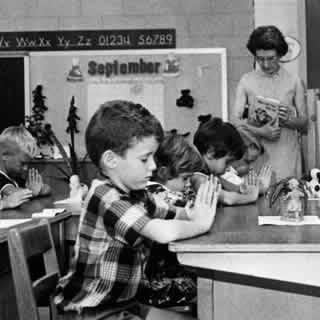Concurrence Douglas | End date 1962 | |
 | ||
Full case name Steven I. Engel, et al. v. William J. Vitale, Jr., et al.' Citations 370 U.S. 421 (more)82 S. Ct. 1261; 8 L. Ed. 2d 601; 1962 U.S. LEXIS 847; 20 Ohio Op. 2d 328; 86 A.L.R.2d 1285 Prior history 191 N.Y.S.2d 453 (Sup. Ct. 1959), aff'd, 206 N.Y.S.2d 183 (App. Div. 1960), aff'd, 176 N.E.2d 579 (N.Y. 1961) Subsequent history 186 N.E.2d 124 (N.Y. 1962) Majority Black, joined by Warren, Douglas, Clark, Harlan, Brennan Similar Lemon v Kurtzman, Abington School District v, Schenck v United States, Gitlow v New York, Mapp v Ohio | ||
Engel v vitale 1962
Engel v. Vitale, 370 U.S. 421 (1962), was a landmark United States Supreme Court case that ruled it is unconstitutional for state officials to compose an official school prayer and encourage its recitation in public schools.
Contents
- Engel v vitale 1962
- Supreme court case engel v vitale
- Background of the state
- Opinion of the Court
- Subsequent jurisprudence
- References
Supreme court case engel v vitale
Background of the state
The case was brought by a group of families of public school students in New Hyde Park, New York, who complained that the voluntary prayer written by the state board of regents to "Almighty God" contradicted their religious beliefs. Led by Steven Engel a follower of Judaism, the plaintiffs sought to challenge the constitutionality of the state's prayer in school policy. They were supported by groups opposed to the school prayer including rabbinical organizations, Ethical Culture, and Judaic organizations. The acting parties were not members of one particular religion; despite being listed in the court papers as an atheist, plaintiff Lawrence Roth later denied this allegation and described himself as religious but not comfortable with prayer. The five plaintiffs were made up of three Jews and two self-proclaimed "spiritual" people who did not belong to any one organized religion. The prayer in question was:
"Almighty God, we acknowledge our dependence upon Thee, and we beg Thy blessings upon us, our parents, our teachers and our country. Amen."
The plaintiffs argued that opening the school day with such a prayer violates the Establishment Clause of the First Amendment to the United States Constitution (as applied to the states through the Fourteenth), which says in part, "Congress shall make no law respecting an establishment of religion, or prohibiting the free exercise thereof." The governments of twenty-two states signed on to an amicus curiae brief urging affirmance of the New York Court of Appeals decision that upheld the constitutionality of the prayer. The American Jewish Committee, the Synagogue Council of America, and the American Ethical Union each submitted briefs urging the Court to instead reverse and rule that the prayer was unconstitutional.
Opinion of the Court
In an opinion delivered by Justice Hugo Black, the Court ruled that government-written prayers were not to be recited in public schools and were a violation of the U.S. Constitution and the Establishment Clause of the first amendment. This was decided in a vote of 6-1, because before the decision could be announced, Justice Felix Frankfurter suffered a cerebral stroke that forced him to retire, and Justice Byron White took no part in the case.
The Court explained the importance of separation between church and state by giving a lengthy history of the issue, beginning with the 16th century in England. It then stated that school's prayer is a religious activity by the very nature of it being a prayer, and that prescribing such a religious activity for school children violates the Establishment Clause. The program, created by government officials to promote a religious belief, was therefore constitutionally impermissible.
The Court rejected the defendant's arguments that people are not asked to respect any specific established religion; and that the prayer is voluntary. The Court held that the mere promotion of a religion is sufficient to establish a violation, even if that promotion is not coercive. The Court further held that the fact that the prayer is vaguely worded enough not to promote any particular religion is not a sufficient defense, as it still promotes a family of religions (those that recognize "Almighty God"), which still violates the Establishment Clause.
Subsequent jurisprudence
Engel became the basis for several subsequent decisions limiting government-directed prayer in school. In Wallace v. Jaffree (1985), the Supreme Court ruled Alabama's law permitting one minute for prayer or meditation was unconstitutional. In Lee v. Weisman (1992), the court prohibited clergy-led prayer at middle school graduation ceremonies. Lee v. Weisman, in turn, was a basis for Santa Fe ISD v. Doe (2000), in which the Court extended the ban to school-organized student-led prayer at high school football games.
